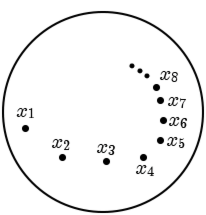| << Chapter < Page | Chapter >> Page > |
The concept of convergence evaluates whether a sequence of elements is getting “closer” to a given point or not.
Definition 1 Assume a metric space and a countably infinite sequence of elements . The sequence is said to converge to if for any there exists an integer such that for all . A convergent sequence can be denoted as or .

Note that in the definition is implicitly dependent on , and therefore is sometimes written as . Note also that the convergence of a sequence depends on both the space and the metric : a sequence that is convergent in one space may not be convergent in another, and a sequence that is convergent under some metric may not be convergent under another. Finally, one can abbreviate the notation of convergence to when the index variable is obvious.
Example 1 In the metric space where , the sequence gives : fix and let (i.e., the smallest integer that is larger than ). If then
verifying the definition. So by setting , we have shown that is a convergent sequence.
Example 2 Here are some examples of non-convergent sequences in :
Theorem 1 If a sequence converges, then its limit is unique.
Proof: Assume for the sake of contradiction that and , with . Pick an arbitrary , and so for the two limits we must be able to find and , respectively, such that if and if . Pick ; using the triangle inequality, we get that . Since for each we can find such an , it follows that for all . Thus, we must have and , and so the two limits are the same and the limit must be unique.
The concept of a Cauchy sequence is more subtle than a convergent sequence: each pair of consecutive elements must have a distance smaller than or equal than that of any previous pair.
Definition 2 A sequence is a Cauchy sequence if for any there exists an such that for all we have .
As before, the choice of depends on , and whether a sequence is Cauchy depends on the metric space . That being said, there is a connection between Cauchy sequences and convergent sequences.
Theorem 2 Every convergent sequence is a Cauchy sequence.

Notification Switch
Would you like to follow the 'Signal theory' conversation and receive update notifications?